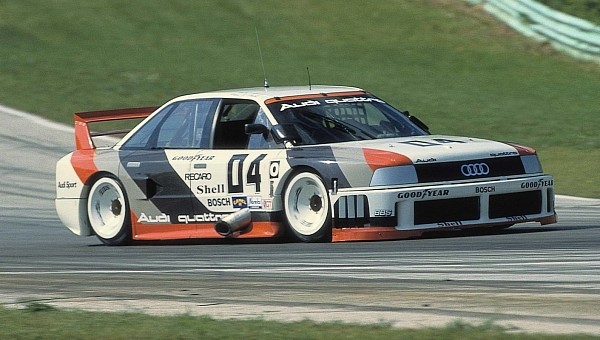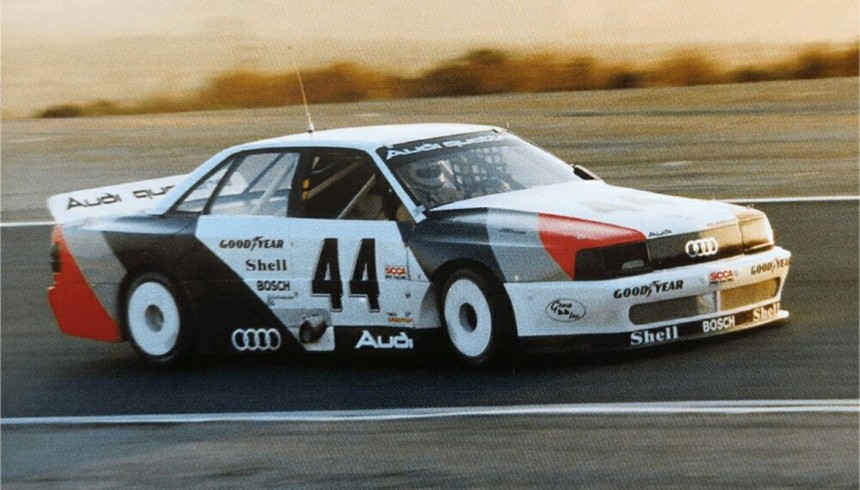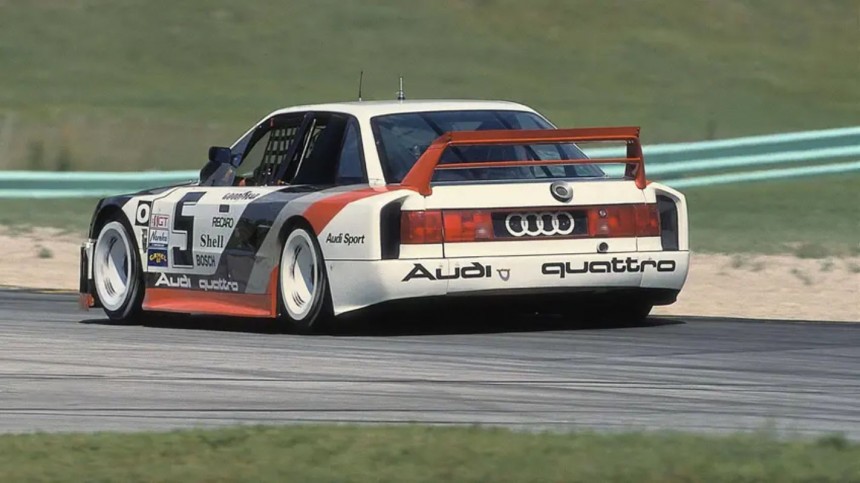The first half of the 1980s was one hell of a ride for the German manufacturer Audi. That era was so good that it influenced American sports cars in such a manner you won't believe it.
The Sport Quattro rally car first won the 1982 WRC (World Rally Championship) and then went on to repeat this performance by winning another title two years later. In addition, Audi came second in 1983 and 1985. Still, by 1986, it had become pretty clear that the Sport Quattro, which, in my opinion, is one of the most incredible vehicles ever created, wasn't as competitive as it once had been. Besides, even if it could win races, Group B of rallying was dead, so Audi went on searching for new competitions. That is how the 90 Quattro IMSA GTO burst onto the scene and changed American sports car racing once and for all.
Audi was in the midst of developing a prototype for Group B and S to extend its domination further because the officials from the German automaker were all in when it was about rallying. However, the FIA (Fédération Internationale de l'Automobile) introduced revised regulations for the WRC in 1987, with the highest class now being Group A.
This was a class in which all competing cars must be based on mass-production vehicles instead of the prototype crazy machines that had dominated without a problem in the 1980s. As a result, Audi turned 200 saloon mass-production cars into rally monsters. However, the brand's management was looking for a way to reach an American audience, and the rally wasn't doing the job. And let's be honest, the American audience did not care at all about the rally, so they didn't watch it.
The Audi Quattro 200 Rally proved mediocre in the 1987 WRC, but the company already had its eyes on a very different prize. So for 1988, Audi took the plunge and reworked the 200 Quattro for the road. Created for the Trans-Am racing series and representing the company's first attempt at a road-racing car for more than 50 years, the 200 Quattro Trans-Am was a pure monster.
It was powered by a 2.1-liter inline five-cylinder engine capable of producing around 500 hp (507 ps), weighing only 1,100 kg (2,425 lbs), and fitted with Audi's famous Quattro all-wheel drive system. Basically, it was built to beat the Americans at their own game. The foreign car proved quick right from the start and terrified the rest of the grid about its capabilities. Appeals were quickly made to do something about it, with the rest of the grid trying everything to level the playing field.
As a result, the regulations were tweaked and changed throughout the season to hinder Audi. For example, they forced the Germans to carry a 50 kg (110 lbs) ballast which was later increased to 100 kg (220 lbs); they tried to narrow their car's air restrictor and even forced them to use narrower tires.
Still, none of those regulation changes worked. Despite the Sports Car Club of America's best efforts, the Quattro Trans-Am beat everyone, winning the constructors' championship for Audi and the drivers' championship for the manufacturer driver Hurley Haywood. And it was a shock for the American motorsport culture.
A German automaker just came in and schooled the American teams in 1988, and so, in 1989, the SCCA (Sports Car Club of America) changed the rules to ban all-wheel drive systems and the use of any engine made outside of the United States. Still, even with all those restrictions, Audi wasn't bothered because they had already laid plans to contest a different event in 1989. They wanted to go bigger and take on the IMSA (International Motor Sports Association).
Like the 200 Quattro that preceded it, the Audi 90 Quattro GTO was based on a regular road-going saloon car. The IMSA regulations were much more relaxed than those used in the Trans-Am, so the only part shared between the 90 models, and its racing brother was the steel roof panel. Simply put, the Audi Quattro 90 IMSA GTO was purely insane. It weighed only 1,200 kg (2,646 lbs) and was powered by a 2.2-liter inline five-cylinder engine capable now of producing nearly 720 hp (730 ps). Besides, it was still using Audi's good old Quattro all-wheel drive system. The company was hoping to achieve at IMSA what they had achieved in the Trans-Am division the year before, which was total domination.
The 90 GTO wasn't like the 200 Trans-Am at all. While the 200 had to be based on a high-volume road car, the GTO did not, and that changed it all. The car was built around a steel space-frame chassis and used lightweight composite materials for all of the bodywork. The wheelbase of the car had to match the production car, and spoilers had to be sold on 250 road-going units. Other than that, regulations permitted almost everything else to be changed.
Audi took the power unit from the Sport Quattro S1 rally car, and they were ready for racing with the suitable modification. The vehicle initially weighed just 900 kg (1,984 lbs) but carried 300 kg (661 lbs) of ballast weight, which the team placed carefully to balance the car as best they could. Still, the season didn't start ideally for Audi. Due to overruling engine development, they missed the first two races of the season, the 24 Hours of Daytona and the 12 Hours of Sebring. Herwart Kreiner, the boss of Audi Sport at that time, was worried the engines wouldn't last the distance and ordered that they be worked on to help reliability before it was allowed to compete on the track.
However, the squad hoped the vehicle would take the competition by storm once it was on track. They had recruited the same driver line-up that had won Trans-Am in the Audi 200 back in 1988, and hopes were high for a repeat. The third race of the season took place in Miami, and Audi did show up this time, though it wasn't one to remember. Hurley Haywood was forced to retire, while Hans Stuck went out with gearbox failure. After three races in the season, the team had a total of zero points.
The team had eight weeks until the next race and took the time to try and work out the kinks. The 90 GTO was the first car Audi had fitted with real-time telemetry, and they recorded speeds, pressures, and temperatures from a van in the paddock. They used this data to refine the car leading up to the fourth race of the season at Summit Point, and it worked. The drivers of the German squad shocked everyone by scoring a one-two finish.
Stuck went on to win the following event as well, but luck wasn't on Audi's side, with damage, crashes, and other issues stopping the GTO's ascent to the top for a few races. However, the team continued to hoover up points where it could.
Towards the end of the season, everything seemed to come together, with Stuck winning five of the last seven races of the season. It all came down to the final race, and Audi had a real chance of victory. The team boss chose to use untested engine components to try and secure an advantage, a move most of the team disagreed with. Ultimately, this decision doomed the cars to fail because the GTOs both retired. As a result, Stuck finished just two points behind championship winner Pete Holmes in the drivers' championship standing. At the same time, the German brand claimed second place in the constructors' championship.
While the result is impressive, at the same time, it was a bitter disappointment for the ever-ambitious Audi. However, the German manufacturer chose to leave IMSA and all US-based after 1989 in order to focus on the DTM touring car series instead. Still, there is no doubt that Audi changed the mindset and influenced American sports car racing forever.
Audi was in the midst of developing a prototype for Group B and S to extend its domination further because the officials from the German automaker were all in when it was about rallying. However, the FIA (Fédération Internationale de l'Automobile) introduced revised regulations for the WRC in 1987, with the highest class now being Group A.
This was a class in which all competing cars must be based on mass-production vehicles instead of the prototype crazy machines that had dominated without a problem in the 1980s. As a result, Audi turned 200 saloon mass-production cars into rally monsters. However, the brand's management was looking for a way to reach an American audience, and the rally wasn't doing the job. And let's be honest, the American audience did not care at all about the rally, so they didn't watch it.
The Audi Quattro 200 Rally proved mediocre in the 1987 WRC, but the company already had its eyes on a very different prize. So for 1988, Audi took the plunge and reworked the 200 Quattro for the road. Created for the Trans-Am racing series and representing the company's first attempt at a road-racing car for more than 50 years, the 200 Quattro Trans-Am was a pure monster.
As a result, the regulations were tweaked and changed throughout the season to hinder Audi. For example, they forced the Germans to carry a 50 kg (110 lbs) ballast which was later increased to 100 kg (220 lbs); they tried to narrow their car's air restrictor and even forced them to use narrower tires.
Still, none of those regulation changes worked. Despite the Sports Car Club of America's best efforts, the Quattro Trans-Am beat everyone, winning the constructors' championship for Audi and the drivers' championship for the manufacturer driver Hurley Haywood. And it was a shock for the American motorsport culture.
A German automaker just came in and schooled the American teams in 1988, and so, in 1989, the SCCA (Sports Car Club of America) changed the rules to ban all-wheel drive systems and the use of any engine made outside of the United States. Still, even with all those restrictions, Audi wasn't bothered because they had already laid plans to contest a different event in 1989. They wanted to go bigger and take on the IMSA (International Motor Sports Association).
Like the 200 Quattro that preceded it, the Audi 90 Quattro GTO was based on a regular road-going saloon car. The IMSA regulations were much more relaxed than those used in the Trans-Am, so the only part shared between the 90 models, and its racing brother was the steel roof panel. Simply put, the Audi Quattro 90 IMSA GTO was purely insane. It weighed only 1,200 kg (2,646 lbs) and was powered by a 2.2-liter inline five-cylinder engine capable now of producing nearly 720 hp (730 ps). Besides, it was still using Audi's good old Quattro all-wheel drive system. The company was hoping to achieve at IMSA what they had achieved in the Trans-Am division the year before, which was total domination.
The 90 GTO wasn't like the 200 Trans-Am at all. While the 200 had to be based on a high-volume road car, the GTO did not, and that changed it all. The car was built around a steel space-frame chassis and used lightweight composite materials for all of the bodywork. The wheelbase of the car had to match the production car, and spoilers had to be sold on 250 road-going units. Other than that, regulations permitted almost everything else to be changed.
However, the squad hoped the vehicle would take the competition by storm once it was on track. They had recruited the same driver line-up that had won Trans-Am in the Audi 200 back in 1988, and hopes were high for a repeat. The third race of the season took place in Miami, and Audi did show up this time, though it wasn't one to remember. Hurley Haywood was forced to retire, while Hans Stuck went out with gearbox failure. After three races in the season, the team had a total of zero points.
The team had eight weeks until the next race and took the time to try and work out the kinks. The 90 GTO was the first car Audi had fitted with real-time telemetry, and they recorded speeds, pressures, and temperatures from a van in the paddock. They used this data to refine the car leading up to the fourth race of the season at Summit Point, and it worked. The drivers of the German squad shocked everyone by scoring a one-two finish.
Stuck went on to win the following event as well, but luck wasn't on Audi's side, with damage, crashes, and other issues stopping the GTO's ascent to the top for a few races. However, the team continued to hoover up points where it could.
While the result is impressive, at the same time, it was a bitter disappointment for the ever-ambitious Audi. However, the German manufacturer chose to leave IMSA and all US-based after 1989 in order to focus on the DTM touring car series instead. Still, there is no doubt that Audi changed the mindset and influenced American sports car racing forever.


















